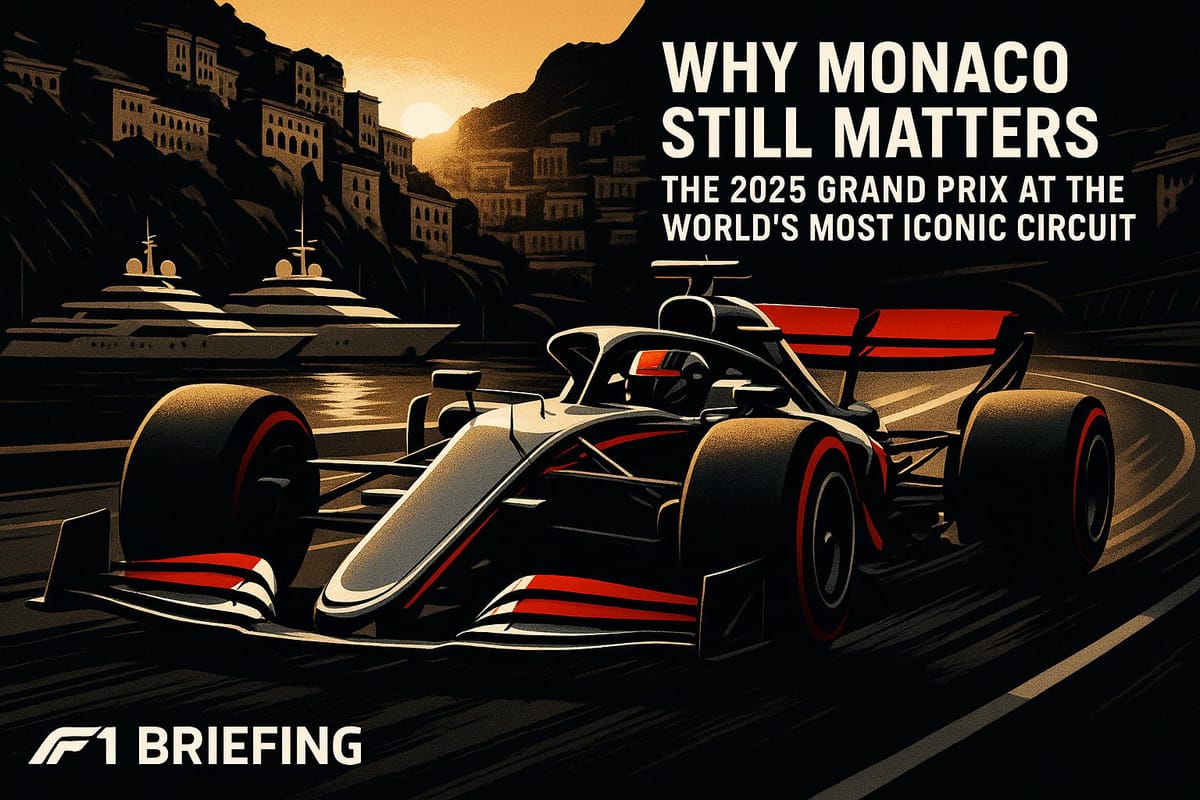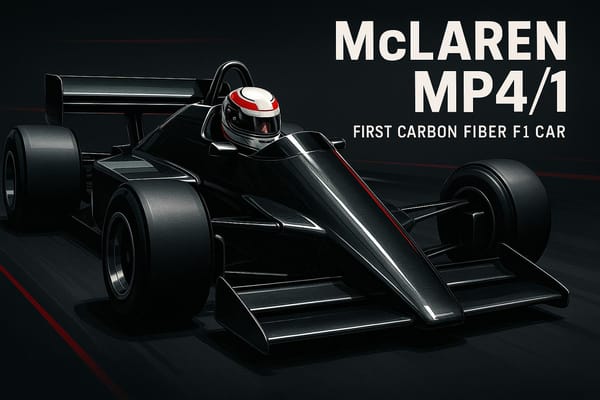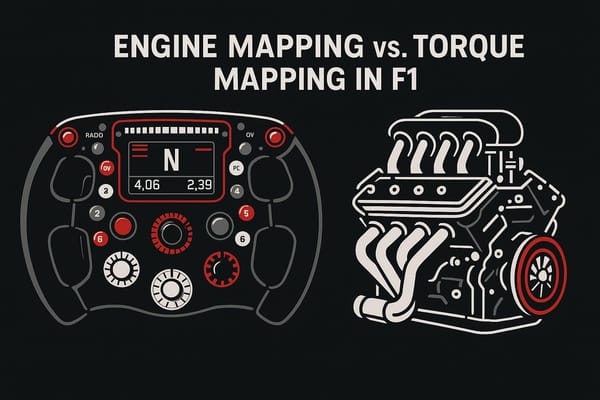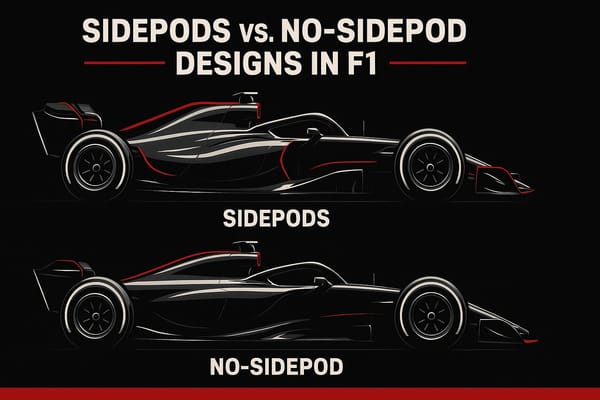Why Monaco Still Matters: The 2025 Grand Prix at the World’s Most Iconic Circuit
Explore the enduring significance of the Monaco Grand Prix, from its historic roots to modern racing challenges and economic impact.

The Monaco Grand Prix remains Formula 1's crown jewel, blending history, luxury, and technical challenges like no other race on the calendar. Here's why it still matters in 2025:
- Historic Significance: First held in 1929, Monaco is one of the oldest and most prestigious F1 circuits.
- Unique Challenges: With 19 tight corners, narrow streets, and the slowest speeds in F1, it demands unmatched precision from drivers and engineers.
- Winning from Pole: Since 2004, over 70% of winners started from pole position, showcasing the importance of qualifying.
- Modern Updates: New regulations like mandatory two-stop strategies and advanced car setups keep the race fresh and competitive.
- Global Appeal: The 2024 race broke U.S. viewership records, drawing nearly 2 million viewers on average.
- Economic Impact: The event generates nearly $100 million in economic benefits for Monaco.
Monaco isn't just a race - it's a spectacle where tradition meets modern motorsport innovation, ensuring its relevance and allure for years to come.
Monaco Grand Prix History
From 1929 to Today
The Monaco Grand Prix began its iconic journey on April 14, 1929, when Antony Noghès organized the first race under the patronage of Prince Louis II. Initially conceived to elevate the Automobile Club de Monaco's status from a regional organization to a national institution, the event has grown into one of Formula One's crown jewels.
Designed by Noghès, the circuit included features that remain legendary today, like the Grand Hotel Hairpin and Sainte Devote. By 1933, the race had earned Grande Épreuve status. When Formula One launched its World Championship in 1950, Monaco was firmly established as a cornerstone of the calendar. While the track has seen minor tweaks over the years, its essence and many of its original 12 corners remain intact.
In 2024, TAG Heuer became Monaco’s first Title Partner, marking a new chapter in the circuit’s evolution. This rich history has laid the groundwork for the unforgettable performances that have come to define the Monaco Grand Prix.
Greatest Monaco Performances
Monaco has been the stage for some of the most memorable moments in Formula One, with drivers achieving legendary status for their performances on this challenging circuit. Here are the most successful drivers in Monaco's history:
| Driver | Wins | Years |
|---|---|---|
| Ayrton Senna | 6 | 1987, 1989, 1990, 1991, 1992, 1993 |
| Graham Hill | 5 | 1963, 1964, 1965, 1968, 1969 |
| Michael Schumacher | 5 | 1994, 1995, 1997, 1999, 2001 |
| Alain Prost | 4 | 1984, 1985, 1986, 1988 |
Ayrton Senna’s incredible 1988 qualifying lap remains one of the most iconic moments in Monaco’s history. McLaren engineer Neil Oatley described it vividly:
"I was running Alain Prost's car. Alain had got down to 1 minute 26.9 seconds. And then Ayrton produced a 24.4 second-lap... Alain improved to 25.4 seconds, but then Ayrton did 23.9 seconds. I remember a kind of ghostly look coming over Alain's face. He just couldn't understand how or where Ayrton's time had come from".
The 1996 Monaco Grand Prix was another unforgettable chapter, with Olivier Panis achieving a shocking victory after starting 14th on the grid. Only three cars crossed the finish line, highlighting how unforgiving the circuit can be. This unpredictability led Nelson Piquet, a three-time world champion, to famously remark that "a win here was worth two anywhere else".
Monaco’s enduring legacy is solidified with its contract extended through 2031, ensuring drivers will continue to tackle its legendary 3.34-kilometer (2.07-mile) layout - the shortest yet one of the most demanding tracks in the championship .
Track Challenges and Requirements
Track Design and Technical Requirements
The Monaco circuit presents a set of unique challenges that push teams to make specific technical adjustments. For instance, F1 cars require modifications like increasing the steering angle from the usual 14° to nearly 20° to handle the track's tight hairpin turns. Its narrow and unconventional layout demands several car tweaks to ensure performance and safety:
| Technical Aspect | Monaco-Specific Requirement |
|---|---|
| Steering Angle | Adjusted to nearly 20° (compared to standard 14°) |
| Suspension Setup | Enhanced to handle the track's uneven surface |
| Rear Wing | Designed for maximum downforce |
| Track Width | Among the narrowest on the F1 calendar |
| Average Speed | One of the lowest in the F1 circuit |
These technical changes highlight the importance of adapting to Monaco's distinctive demands, making qualifying performance crucial for success.
Qualifying Priority and Passing Limits
In Monaco, the emphasis on qualifying cannot be overstated. Teams approach practice sessions cautiously, gradually building up the pace required for a strong qualifying performance. This is vital, as overtaking on the narrow streets of Monaco is notoriously difficult. McLaren Engineer Jose Manuel López explains:
"In Monaco, that's no different, but it challenges the drivers even more, with the risk of hitting the crowns of the road, which is significant in Monaco, particularly at Turn 1 and all the way up the hill to Turn 3."
Key Track Sections
Monaco's technical demands are further amplified by specific sections of the track that test drivers' skill and precision:
-
Casino Square Complex
This section requires drivers to maintain momentum while navigating dangerously close to barriers. -
Fairmont Hairpin
Known as the tightest corner in F1, it demands special steering adjustments and careful tire management to navigate successfully. -
Swimming Pool Complex
A high-speed chicane where absolute precision is critical. Even the smallest error can result in contact with the barriers.
Nelson Piquet once described driving at Monaco as being "like riding a bicycle around your living room". This vivid analogy perfectly captures the unparalleled precision required on this circuit, where even the slightest misstep can bring a race to an abrupt end.
Modern F1 Racing at Monaco
Tire Management
Monaco's reputation for pushing drivers and teams to their limits continues with the 2025 race introducing new tire strategy rules. Under the updated regulations, teams are required to make at least two pit stops and use a minimum of three sets of tires, incorporating at least two different compounds in dry conditions. This adds an extra layer of complexity to a race already known for its unique challenges. And with Monaco’s race distance of 260 km - shorter than the standard 305 km - teams must strike a delicate balance between conserving tires and maintaining competitive lap times.
Max Verstappen, known for his straightforward approach, shared his thoughts on the changes:
"I don't know if it's going to make a massive difference, but I don't mind. If it's one stop, two stops, 25 stops, it's all fine. I mean, I do whatever is decided, right?"
This shift in tire strategy ties directly into the technical adjustments teams make to optimize performance.
Aerodynamic Setup
Monaco's tight, winding streets demand a very different approach to car setup, with teams focusing on maximizing downforce instead of chasing top-end speed. Here’s a look at some of the technical innovations introduced by leading teams:
| Team | Technical Innovation | Performance Impact |
|---|---|---|
| Red Bull | Deeper-dished rear wing profile | Boosts downforce by manipulating air pressure |
| Mercedes | McLaren-style "teeth" vanes | Improves airflow direction across the car's bodywork |
| Ferrari | Revised wing mirrors | Enhances aerodynamic efficiency |
| Force India | Dual small T-wing setup | Provides modest improvements in cornering grip |
These adjustments are carefully designed to enhance cornering ability while keeping drag manageable - an approach that has proven effective in previous seasons.
Data Analysis Methods
In addition to physical upgrades, teams rely heavily on advanced data tools to fine-tune their strategies. These methods allow them to anticipate race developments and make informed decisions on the fly.
Safety Car Prediction
Safety cars are a frequent sight at Monaco, appearing in 10 of the last 15 races. Teams analyze historical data to predict when a safety car might be deployed, using this information to adjust pit stop timing and gain a strategic edge.
Tire Performance Modeling
Using sophisticated modeling tools, teams can forecast tire degradation and determine the optimal performance windows. For example, during the 2021 Monaco Grand Prix, data analysis helped Max Verstappen maintain consistent lap times in the 1:16 range, effectively preventing competitors from executing an undercut.
Sebastian Vettel's past performance highlights the importance of data-driven decisions:
"Towards the end of the race the tyres I had were nowhere close to fresh, but I saw the only way to win the race was to stay out"
Weather forecasting is another critical piece of the puzzle. Monaco's unpredictable weather can flip strategies on their head, so teams integrate weather data with performance metrics to create dynamic models that adapt to changing conditions. In a race where margins for error are razor-thin, these tools can make all the difference.
Monaco's Business and Social Impact
Global Media Coverage
The 2024 Monaco Grand Prix smashed U.S. viewership records, drawing an average of 1.965 million viewers on ABC, with a peak of 2.3 million between 11:15 and 11:30 AM ET. This marked a 7% increase compared to 2023. F1 analyst Vincenzo Landino highlighted Monaco's significance by stating:
"Monaco epitomizes what F1 is. You get rid of that, now you have a brand crisis, in my opinion."
These numbers underscore Monaco's global appeal and its ability to captivate audiences, further amplifying its economic and cultural influence.
Local Economic Benefits
The four-day Grand Prix event brings a massive financial boost to the region:
| Economic Impact Category | Amount (USD) |
|---|---|
| Direct Benefits | $23.6 million |
| Indirect Benefits | $74.5 million |
| Total Impact | $98.1 million |
With daily attendance ranging from 50,000 to 65,000, the event attracts over 200,000 visitors in total. Interestingly, 40% of these spectators don’t have direct track views but still flock to Monaco for the experience. Hotels in the area hit near-100% occupancy during race week, showcasing the event's pull.
Luxury Brand Connections
Monaco’s influence isn’t just limited to media and economics - it’s also a hotspot for luxury branding. Take TAG Heuer, for example. Their iconic clocks are a staple throughout the paddock, reinforcing the brand’s deep connection to the Grand Prix. TAG Heuer CEO Antoine Pin remarked:
"Monaco is truly our spiritual home, encapsulating much of what we stand for at TAG Heuer."
Louis Vuitton also shines during the event, crafting a bespoke trophy trunk inspired by Monaco's flag and the circuit’s 19-turn layout.
Interestingly, Monaco’s hosting fee is relatively modest compared to other venues. While Saudi Arabia and Bahrain pay over $50 million annually to host F1 races, Monaco’s fee is around $20 million. This lower cost, combined with its prestige, makes it a standout on the F1 calendar.
Monaco's Place in Modern F1
Current Challenges
Modern Formula 1 has put Monaco's adaptability to the test. The 2024 race revealed some of these challenges, as the top 10 drivers finished in the same positions they started. The wider, modern F1 cars make overtaking on Monaco's tight streets incredibly difficult. Here's a snapshot of the 2024 Monaco Grand Prix:
| Race Element | 2024 Monaco Statistics |
|---|---|
| Overtakes Completed | 21 |
| Safety Car Probability | 71% |
| Virtual Safety Car Probability | 57% |
| Pit Stop Time Loss | 20 seconds |
Source:
Charles Leclerc, reflecting on the race dynamics, shared his thoughts on the need for strategic changes:
"I think it will definitely help the Sunday, especially with strategy. The excitement on Sunday is maybe a bit less than what you will hope. The Saturday is incredible but the Sunday maybe need a little bit of spice and hopefully this will give it."
These challenges have pushed Monaco to evolve, sparking updates to the track and race strategies.
Track Updates and Changes
Monaco's contract extension through 2031 has driven significant developments to keep the circuit relevant. Former Renault F1 driver Jolyon Palmer highlighted the unique demands of the track:
"Monaco is a beautiful circuit and a true driver's track. It feels like madness in an F1 car; even in comparison to other street circuits it's so narrow, the roads are cambered, it's tight and twisty and there are challenges everywhere..."
To address these challenges, the track has undergone modifications that align with the technical demands of modern high-downforce cars. Additionally, the circuit is reconditioned nightly during the race weekend, adding another layer of complexity for teams and drivers.
Formula 1 President and CEO Stefano Domenicali emphasized the race's iconic status:
"The streets of Monte Carlo are unique and a famous part of Formula 1, and the Monaco Grand Prix remains a race that all drivers dream of winning."
Despite being just 3.34 km long, Monaco continues to prove its importance in the F1 calendar. The 2024 race not only showcased the circuit’s enduring appeal but also broke records, becoming the most-watched Monaco Grand Prix in U.S. history and the third most-viewed F1 race ever in the United States.
From Roads to Racetrack: The Ultimate Monaco Grand Prix Circuit Tour
Conclusion
Monaco's lasting prominence in Formula 1 is evident in its contract extension through 2031 and the anticipation of its 75th anniversary on the official calendar in 2025. In 2024, the Monaco Grand Prix set a new benchmark for viewership in the United States, highlighting its worldwide appeal.
Beyond the impressive statistics, the Automobile Club of Monaco has secured a fixed calendar spot starting in 2026 - taking place during the first full weekend of June. Known for its unique challenges and technical demands, Monaco is also looking ahead, embracing sustainability efforts and fine-tuning its place in the F1 schedule to remain relevant in the modern era.
Formula 1 President and CEO Stefano Domenicali captured this evolution when he stated:
"This agreement signals a new era of partnership and innovation between Formula 1 and Monaco. It is the future focused leadership of H.S.H. Prince Albert II of Monaco which will allow us to create an optimised calendar, which reduces pressure on logistics, and to decrease the environmental impact of our global championship, as we continue the path towards our Net Zero goal by 2030."
Blending its rich history with forward-thinking initiatives, Monaco continues to stand as a timeless and essential part of the Formula 1 championship, balancing tradition with progress to maintain its iconic status.
FAQs
Why is qualifying so important at the Monaco Grand Prix?
Qualifying holds immense importance at the Monaco Grand Prix, largely because overtaking on this legendary track is notoriously difficult. The circuit's narrow streets and sharp corners make it incredibly tricky for drivers to find opportunities to pass their rivals.
Securing a spot at the front of the grid offers a massive edge. It allows drivers to control the race pace and steer clear of the chaos that often unfolds further back. In Monaco, where track position is everything, a standout qualifying session is absolutely crucial for anyone with their sights set on winning.
How do Monaco’s unique track conditions impact car setup and race strategy?
Monaco’s legendary circuit stands apart in Formula 1, known for its tight streets, sharp turns, and scarce opportunities for overtaking. Because of these challenging conditions, track position becomes incredibly important. As a result, teams pour their efforts into nailing qualifying sessions and crafting sharp race strategies.
Starting in 2025, a new rule will require drivers to make at least two pit stops, using three sets of tires in both wet and dry conditions. This change adds a layer of complexity to race strategies, as teams will need to juggle tire wear, pit stop timing, and the unpredictable nature of safety cars or weather changes. To tackle Monaco’s demanding layout, cars are usually configured with maximum downforce. This setup prioritizes grip and control through the circuit’s tight corners, even if it means sacrificing straight-line speed.
What is the economic and cultural significance of the Monaco Grand Prix, both locally and globally?
The Monaco Grand Prix: Economic and Global Impact
The Monaco Grand Prix stands out as more than just a Formula One race - it’s a major event with a significant economic and international impact. Over a few days, it’s estimated to pump around $95 million into the economy, with much of that directly benefiting Monaco through tourism, hospitality, and related industries. Local hotels often hit full capacity, highlighting the event’s ability to draw massive crowds.
Beyond its financial influence, the race plays a key role in shaping Monaco’s global image. It attracts fans, celebrities, and media from all over the world, reinforcing its reputation as a hub of luxury and excitement. With its rich history and prestige, the Monaco Grand Prix has become a symbol of high-stakes competition and exclusivity. Interestingly, it’s the only Grand Prix that doesn’t pay a hosting fee, a testament to its unparalleled value within the Formula One calendar.




